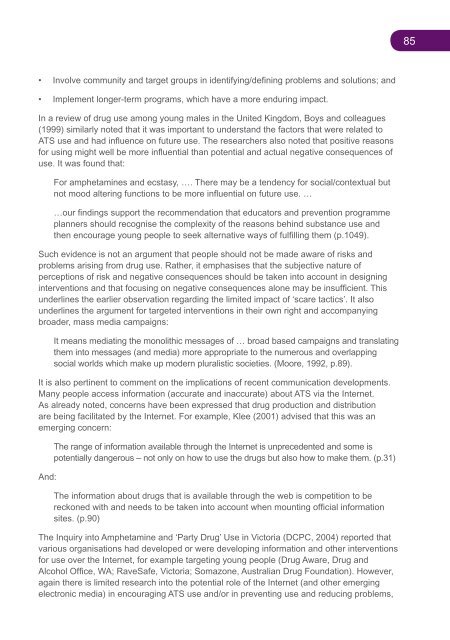National Amphetamine-Type Stimulant Strategy Background Paper
National Amphetamine-Type Stimulant Strategy Background Paper
National Amphetamine-Type Stimulant Strategy Background Paper
You also want an ePaper? Increase the reach of your titles
YUMPU automatically turns print PDFs into web optimized ePapers that Google loves.
85<br />
• Involve community and target groups in identifying/defining problems and solutions; and<br />
• Implement longer-term programs, which have a more enduring impact.<br />
In a review of drug use among young males in the United Kingdom, Boys and colleagues<br />
(1999) similarly noted that it was important to understand the factors that were related to<br />
ATS use and had influence on future use. The researchers also noted that positive reasons<br />
for using might well be more influential than potential and actual negative consequences of<br />
use. It was found that:<br />
For amphetamines and ecstasy, …. There may be a tendency for social/contextual but<br />
not mood altering functions to be more influential on future use. …<br />
…our findings support the recommendation that educators and prevention programme<br />
planners should recognise the complexity of the reasons behind substance use and<br />
then encourage young people to seek alternative ways of fulfilling them (p.1049).<br />
Such evidence is not an argument that people should not be made aware of risks and<br />
problems arising from drug use. Rather, it emphasises that the subjective nature of<br />
perceptions of risk and negative consequences should be taken into account in designing<br />
interventions and that focusing on negative consequences alone may be insufficient. This<br />
underlines the earlier observation regarding the limited impact of ‘scare tactics’. It also<br />
underlines the argument for targeted interventions in their own right and accompanying<br />
broader, mass media campaigns:<br />
It means mediating the monolithic messages of … broad based campaigns and translating<br />
them into messages (and media) more appropriate to the numerous and overlapping<br />
social worlds which make up modern pluralistic societies. (Moore, 1992, p.89).<br />
It is also pertinent to comment on the implications of recent communication developments.<br />
Many people access information (accurate and inaccurate) about ATS via the Internet.<br />
As already noted, concerns have been expressed that drug production and distribution<br />
are being facilitated by the Internet. For example, Klee (2001) advised that this was an<br />
emerging concern:<br />
And:<br />
The range of information available through the Internet is unprecedented and some is<br />
potentially dangerous – not only on how to use the drugs but also how to make them. (p.31)<br />
The information about drugs that is available through the web is competition to be<br />
reckoned with and needs to be taken into account when mounting official information<br />
sites. (p.90)<br />
The Inquiry into <strong>Amphetamine</strong> and ‘Party Drug’ Use in Victoria (DCPC, 2004) reported that<br />
various organisations had developed or were developing information and other interventions<br />
for use over the Internet, for example targeting young people (Drug Aware, Drug and<br />
Alcohol Office, WA; RaveSafe, Victoria; Somazone, Australian Drug Foundation). However,<br />
again there is limited research into the potential role of the Internet (and other emerging<br />
electronic media) in encouraging ATS use and/or in preventing use and reducing problems,

















